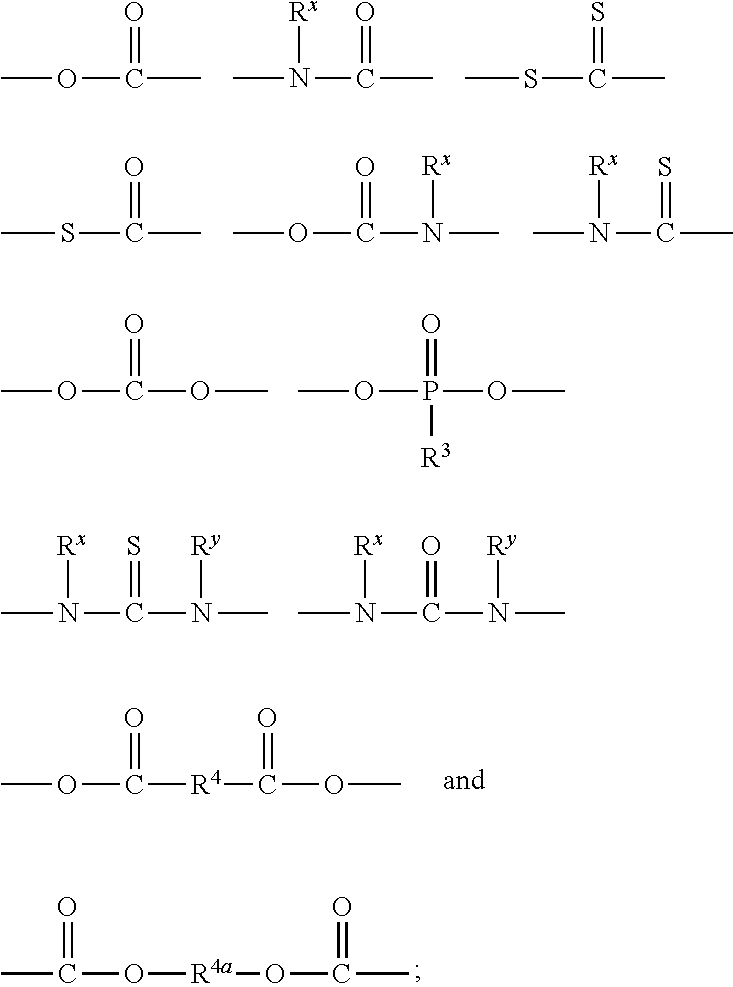Polymeric biomaterials derived from phenolic monomers and their medical uses
a technology of phenolic monomers and polymer biomaterials, which is applied in the field of polymer biomaterials, can solve the problems of bioresorbtion and/or biodegradation tending to alter mechanical properties in unpredictable ways, and the thermochemical processing is more difficult, so as to reduce the level of amide hydrogens, increase the resorption rate of polymers, and reduce the melting viscosity of polymers
- Summary
- Abstract
- Description
- Claims
- Application Information
AI Technical Summary
Benefits of technology
Problems solved by technology
Method used
Image
Examples
example 1
of 4-Hydroxyphenethyl 3-(4-Hydroxyphenyl)Propanoate (DTy)
[0218]Into a 500 mL round bottomed flask fitted with an overhead stirrer, and a modified Dean-stark trap for solvents heavier than water were added 10 g (72 mmol) of tyrosol, 13 g (78 mmol) of desaminotyrosine (DAT), 0.65 g (3.4 mmol) of 4-toluenesulfonic acid monohydrate, and 200 mL of 1,2-dichloroethane (DCE). A water-cooled reflux condenser was placed on top of the modified Dean-stark trap and the contents of the flask were heated to reflux while being stirred. The reaction was continued until approximately 1.4 mL of water collected in the modified Dean-stark trap above the DCE and the water collection essentially stopped (about 4 hours of reflux). The reaction mixture was cooled to room temperature when the crude product precipitated as off-white crystalline solid, which was dissolved in 100 mL of ethyl acetate and washed twice with 100 mL portions of 5% sodium bicarbonate solution. After drying over magnesium sulfate the ...
example 3
of Dityrosyl Succinate
[0226]Into a 500 mL round bottomed flask fitted with an overhead stirrer, and a modified Dean-stark trap for solvents heavier than water were added 25.0 g (0.181 mol) of tyrosol, 9.56 g (0.088 mol) of succinic acid, 3.44 g (18.1 mmol) of 4-toluenesulfonic acid monohydrate, and 200 mL of DCE. A water-cooled reflux condenser was attached to the top of the modified Dean-stark trap and the contents of the flask were heated to reflux while being stirred. The reaction was continued until approximately 3.2 mL of water collected in the modified Dean-stark trap above the DCE and the water collection essentially stopped. The reaction mixture was allowed to cool to room temperature while stirring was continued. The product that precipitated was isolated by filtration and washed with 2×50 mL of DCE. 1H NMR showed residual PTSA and tyrosol. For purification the solid was stirred with 150 mL of aqueous 5% NaHCO3 for 3 h using overhead stirrer. The product was isolated by fil...
example 4
of Dityrosyl Oxalate
[0227]Into a 500 mL round bottomed flask fitted with an overhead stirrer, and a modified Dean-stark trap for solvents heavier than water were added 25.0 g (0.181 mol) of tyrosol, 8.00 g (0.088 mol) of Oxalic acid, 3.44 g (18.1 mmol) of 4-toluenesulfonic acid monohydrate, and 200 mL of 1,2-DCE. A water-cooled reflux condenser was attached to the top of the modified Dean-stark trap and the contents of the flask were heated to reflux while being stirred. The reaction was continued until approximately 3.2 mL of water collected in the modified Dean-stark trap above the DCE and the water collection essentially stopped. The reaction mixture was allowed to cool to room temperature while stirring was continued. The product that precipitated was isolated by filtration and washed with 2×50 mL of DCE. For purification the solid was stirred with 150 mL of aqueous 5% NaHCO3 for 3 h using overhead stirrer. The product was isolated by filtration and washed with 3×50 mL of DI wat...
PUM
| Property | Measurement | Unit |
|---|---|---|
| atomic number | aaaaa | aaaaa |
| atomic number | aaaaa | aaaaa |
| Tm | aaaaa | aaaaa |
Abstract
Description
Claims
Application Information
 Login to View More
Login to View More - R&D
- Intellectual Property
- Life Sciences
- Materials
- Tech Scout
- Unparalleled Data Quality
- Higher Quality Content
- 60% Fewer Hallucinations
Browse by: Latest US Patents, China's latest patents, Technical Efficacy Thesaurus, Application Domain, Technology Topic, Popular Technical Reports.
© 2025 PatSnap. All rights reserved.Legal|Privacy policy|Modern Slavery Act Transparency Statement|Sitemap|About US| Contact US: help@patsnap.com



